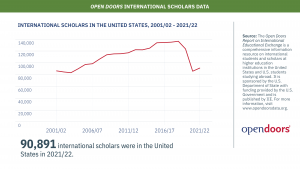The findings of the Open Doors international scholars research shows that China and India are still the leading places of origin for international scholars in the US, with the two countries making up over 38% of all international scholars in the country.
However, in 2020/21 there was a decline of 26% of scholars from China, while the number of scholars from India increased by 17% during the same period.
Many leaders at HEIs attribute this to the easing of travel restrictions, according to IIE’s head of research, evaluation, and learning Mirka Martel.
“While we are not yet seeing a full rebound to pre-pandemic totals, we are seeing a positive trend in numbers this year,” she said.
The latest survey of 1,700 US institutions asking about scholar mobility flows to the US shows a gradual rise after the Covid-19 pandemic. The 2019/20 release saw the number of international scholars fall by 13,055, while the following year saw a further 30% decline.
The number dropped below 100,000 in 2020/21 for the first time since the 2006/7 academic year – a total it has not yet returned to.
International scholars include postdoctoral students, visiting lecturers and researchers, and short-term scholars or visiting specialists.
“We have seen robust growth in European countries that have fared also very well”
The remaining five top countries of origin are South Korea with 5,439 (+10.4%), Canada with 3,993 (+3.4%) and Germany with 3,389 (+40.1%).
“We have also seen an increase in scholars from South Korea,” Martel added.
“In addition, we have seen robust growth in European countries that have fared also very well. And international scholars from Germany, Italy, France, and Spain have also seen significant percentage increases.”
Brazil increased by 27.4% to reach 3,292, Italy by 29.% to hit 2,948, France by 22.3% to 2,590 and Spain by 37.5% to 2,136.
Pakistan saw a marked increase of 56.1%, sending 1,280 researchers and lecturers, as did Colombia, which rose by 45.8%, sending 1,133. A 56.3% rise among Nigerian academics saw 616 travel to the US.
She also noted during the February 8 data release webinar that IIE will be “watching this data closely in the coming year”, as China is the leading country of origin for international scholars coming to the US.
The top states scholars were drawn to for their 2021/22 activities were California, Massachusetts, New York, Pennsylvania and Texas.
IIE research specialist Julie Baer addressed the academic activities of international scholars. “Research has traditionally been the primary activity of international scholars in the US,” she offered, with three out of four scholars conducting research in the US.
Approximately 9% were engaged in teaching activities, while 8% were engaged in a combination of research and teaching, a slight increase from the past few years.
At 79%, most international scholars specialised in the STEM fields, which included physical and life sciences, engineering, health professions, math and computer science, and agriculture. A far smaller percentage of scholars conducted activities in the social sciences and business and management.
Several years ago, IIE started collecting data on scholars’ duration of stay in the US. “Since international scholars conduct a wide array of activities, from leading research projects, to attending symposia, the length of stay can vary quite significantly,” Baer said.
While a “notable uptick” was seen in short-term appointments from 24% to 31% this year and the number of long-term stays remaining consistent over the past few years, mid-length durations continue to be the most popular length of stay.
Baer underscored the support of international scholars by HEIs. “Most colleges and universities have continued to prioritise communication with scholars, either in welcoming new scholars or supporting scholars.”
She listed providing information about health, safety and wellbeing, along with providing information on travel and visa procedures and virtual support via technology as ways HEIs are ramping up support efforts.
The survey data was drawn from July 1, 2021 to June 30, 2022, a time when many students and faculty had returned to in-person classes on campus.
For over seven decades, IIE has been publishing Open Doors with the support of the US Department of State’s Bureau of Educational and Cultural Affairs. It is composed of four separate surveys sent to around 1,700 HEIs in the US annually.


